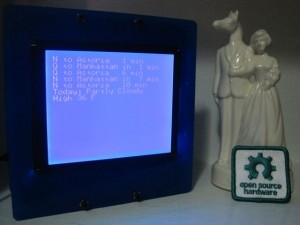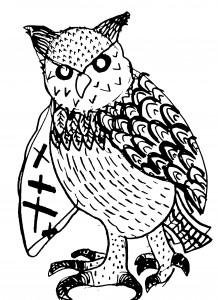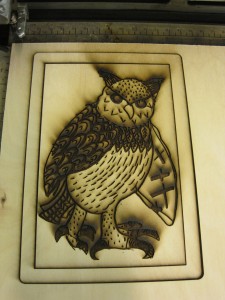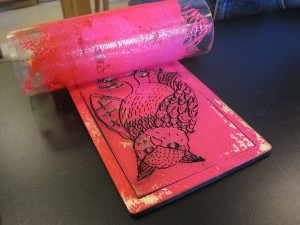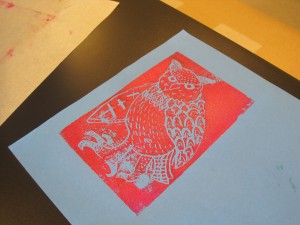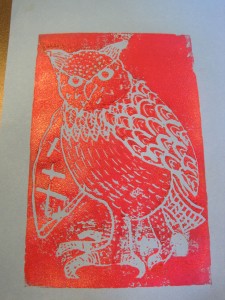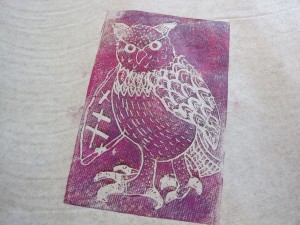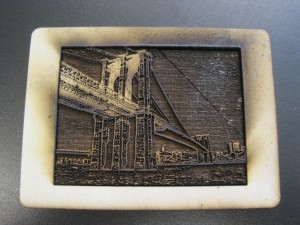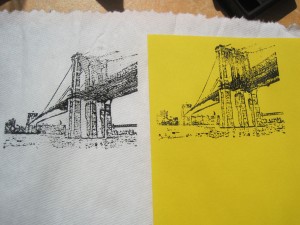Archive for the ‘Uncategorized’ Category
Some Advice for Maker Education
A head of school recently emailed because her school is starting a STEAM Studio and she wanted some advice on beginning the program. Here is what I wrote to her. Maybe it can help some others:
My advice is to start by coming up with a few skill-building projects that are open enough so that students can tailor them to whatever they are passionate about but focused enough that there are some existing resources (ie Make Magazine or Instructables) to help them be as self guided as possible. Don’t try to assign the same project to everyone in the class. It’s essential that the students are working on projects that are personally meaningful to them. Don’t get too wrapped up in the “solving real world problems” with “design thinking” trend. Encourage whimsy and imagination in their projects. Give the students as much time as possible to explore and tinker with their ideas and materials. Read “Invent to Learn” if you have not already.
Resources for Makers and Educators
I’ve been giving a lot of presentations lately about Making and Education. People often ask me for a list of resources. Here is my attempt to put one together. This list could go on and on. If anyone has any other suggestions, please leave them in the comments and I’ll add them to the list. Thank you. Now get out there and make something!
Email Discussion Group:
https://groups.google.com/forum/#!forum/k-12-fablabs
Academic Papers:
The Democratization of Invention Blickstein, Paulo
Kindergarten Approach to Learning Resnick, Mitchel
Tools and Software:
http://www.arduino.cc
http://www.processing.org
http://scratch.mit.edu/
http://www.picocricket.com/picoboard.html
http://www.tinkercad.com
http://www.makerbot.com
http://www.epiloglaser.com
http://www.shopbottools.com
For Project Ideas:
http://www.exploratorium.edu/pie/ideas.html
http://www.tinkeringschool.com/projects/
http://tinkering.exploratorium.edu/activities/
http://makezine.com/
http://www.instructables.com/
http://hlt.media.mit.edu/
http://openmaterials.org/
www.diy.org/skills
www.makeprojects.com
http://howtosmile.org/
Curriculum:
http://curriculum.makerbot.com/
learn.sparkfun.com
learn.adafruit.com
http://itp.nyu.edu/physcomp/Tutorials/Tutorials
For Inspiration:
http://itp.nyu.edu/itp/gallery/
http://bildr.org/
http://www.robives.com/mechs
http://www.makingthingsmove.com/resources
http://itp.nyu.edu/physcomp/
Suppliers
http://www.adafruit.com
http://www.sparkfun.com
inventables.com
http://www.jameco.com
General Resources for Makerspaces
makerspace.com
http://hackerspaces.org
http://www.mtelliottmakerspace.com/?page_id=166
Professional Development:
http://constructingmodernknowledge.com/cmk08/
http://el.media.mit.edu/logo-foundation/workshops/summer.html
http://itp.nyu.edu/camp2013/
Books:
Goyal, Nikhil. One Size Does Not Fit All: A Student’s Assessment of School
Thomas, Douglas; Seely Brown, John. A New Culture of Learning: Cultivating the Imagination for a World of Constant Change
Martinez, Sylvia Libow; Stager, Gary S. Invent to Learn: Making, Tinkering, and Engineering in the Classroom
Margolis, Jane. Unlocking the Clubhouse
Gershenfeld, Neil. Fab: The Coming Revolution on Your Desktop–from Personal Computers to Personal Fabrication
November, Alan. Who Owns the Learning
Honey, Margaret; Kanter, David. Design Make Play, Growing the Next Generation of STEM Innovators
Making Things Talk: Using Sensors, Networks, and Arduino to see, hear, and feel your world by Tom Igoe
Permalink: http://amzn.com/1449392431
Physical Computing: Sensing and Controlling the Physical World with Computers by Dan O’Sullivan
Permalink: http://amzn.com/159200346X
Make: Electronics (Learning by Discovery) by Charles Platt
Permalink: http://amzn.com/0596153740
Getting Started in Electronics by Forrest M. Mims III
Permalink: http://amzn.com/0945053282
Getting Started with Arduino by Massimo Banzi
Permalink: http://amzn.com/1449309879
Making Things Move DIY Mechanisms for Inventors, Hobbyists, and Artists by Dustyn Roberts
Permalink: http://amzn.com/0071741674
Getting Started with Processing by Casey Reas
Permalink: http://amzn.com/144937980X
Building Wireless Sensor Networks: with ZigBee, XBee, Arduino, and Processing by Robert Faludi
Permalink:
My First Makerspace
This essay was written as a response to Seymour Papert’s introduction to Mindstorms, Gears of my Childhood, for the Learning Creative Learning Class at MIT: http://learn.media.mit.edu/syllabus.html
Even at the age of seven, I had a makerspace. The cellar of our family home in suburban New Jersey was dark in corners and the cement floor was cold year round. But the combination of semi-discarded machines, random material selection, and my father’s seldom-used tools turned this underground cavern into my own proto-fablab, a place where I was free to imagine and explore with making things, where I could tinker and create, a place where I could learn at my own pace and study in my own way.
My workshop was huge, encompassing the entire footprint of the largest house in the neighborhood. A generic wooden staircase descended into the middle of the room, splitting the floor plan into four main sections. The right side of the wall facing the base of the stairs was lined with the hot water tank and furnace that warmed the house. Mysterious noises would emanate from this area of the basement. Sometimes my brothers would cruelly turn off the switch at the top of the stairs and the only light in the room would be the flickering blue glow of the furnace reflecting on the shiny concrete floor.
Turning right to face the front of the house, one long windowless wall was lined floor to ceiling with steel shelves. These muscle rack units were stacked with junk and treasures packed into boxes and old luggage. There did not seem to be any order to what was in each container. So it was up to me and my brothers to find out. The lower shelves were filled with boxes of our old toys and broken sports equipment. This discarded bric-a-brac became raw materials for make believe and fantasy. The upper shelves seemed to contain older items, foreign detritus from our parent’s childhoods. Reaching these archaic items was dangerous. The shelves were free standing and we had to climb up them to reach the upper levels. More than once, a whole shelving unit tipped over on a small child, spilling ancient report cards and thank you notes all over the concrete.
One entire shelving unit, closest to the staircase, was filled with my father’s tools. This was my favorite of all the shelves. I knew I was not supposed to play with these adult toys, but there was something magnetic about them, their heft and their power. On the lower shelves were one large box of nails and one large box of screws. When my parents were not home, or if they were all the way upstairs two floors removed from the basement, I would bang those nails with a hammer into scrap two-by-four at wild angles bending them haphazardly. Then I would use the pry bar on the hammer to remove the nails slowly. Some of the nails were harder to pry out. I remember discovering that a small block of material between the claw and wood would help pull out those more difficult nails.
On one of those shelves just above my head, my dad kept a few big 12 volt batteries. I have no idea what they were for, but I’ll never forget when one fell on my big toe while I was trying to climb up and pull it down off its perch. I lost my toenail soon afterwards. I used to love those batteries. They were so different from the wimpy batteries that powered my toys and remote controls. I remember playing with those giants and how I discovered that placing a nail across the two metal springs would produce a shower of sparks. My early experiments with electricity were fueled by a dangerous level of unbridled curiosity. I would connect my toys to those big boxy batteries and observe the effects. Sometimes my poor toys would make crazy sped-up noises, or popping sounds and smoke. Usually they would stop working afterwards.
I lost interest in those batteries once I discovered the power of alternating current. In fact my favorite toy growing up was an old electrical power cord that had been pulled out of a lamp. I don’t remember where I found it. Maybe in one of those boxes on the shelves, or more likely, I cut it off a lamp myself. I used to run tests where I’d send 120 volts of alternating current through various materials, and observe the results. My favorite objects to observe were metal bolts; they would get white hot. I could pick them up with pliers and burn hexagonal holes in paper or plastic. Now that I know a bit more about electricity, I realize my experiments could have caused some serious accidents. But I learned more about the principles of nature by getting electrocuted through that damn lamp cord, than I ever could have in a classroom.
In fact I learned plenty of real lessons in that basement that I never could have learned in school. In school the advisors and psychologists were saying that I had an attention deficit, that I had a hard time paying attention to the task at hand. In classes where we had to sit row by row for 45 minutes at a time listening to a teacher talk about science or math, I was dreaming of doing science and math in the basement. And as soon as I got home, I would forget about that two page worksheet that I was supposed to fill out for homework and get right to working on blueprints for my latest creation. In school I was a failure, but in the basement I was a designer, an engineer, and an inventor. In the basement, I would take stuff apart and put stuff back together. I was always trying to figure out how things worked. I would make things and often break things.
When Dad brought home a brand new Sony Triniton TV, everyone in the family was excited about the huge curved glass and those giant red, blue, and green pixels. But I was more excited about the prospect of disassembling the old TV, an ancient black and white box. I was convinced that if I could take the television apart, I could figure out how to source all the individual parts, but smaller, and build my own handheld television set. Of course once I took that box apart, I saw how complex the system inside really was. I kept breaking that TV down into smaller and smaller parts until every single screw was removed and the giant glass cathode ray tube stood alone. It was not until years later, in graduate school, when I learned that the capacitors inside a television set hold enough current to kill an adult.
Not all of my explorations in the basement were as dangerous as the electricity and pyrotechnics experiments. Most of my time down there was spent playing and building with a set of materials that included a giant rolled-up wall-to-wall carpet, a bed frame on wheels, a pile of scrap two-by-fours, plywood, bricks, and cardboard. This stock of components was enough to build space ships and racecars, forts and portable lemonade stands.
One winter, I decided to build a snow bike. In the basement, I had all of the supplies and tools that I needed. The bicycle that I learned how to ride on was small but heavy, a pink and white trainer with tassels on the handlebars. I studded the solid rubber back tire with screws spaced every inch around the entire circumference. I attached a short child size ski with c-clamps cuffed around the bindings and the rim of the front tire. I’ll never forget the satisfaction that I felt as I rode that pink bike around the snow covered streets of the neighborhood. It might have been the first time I made a real working prototype of one of my inventions.
When I was twelve years old, my family moved to another town, another house. A house without a basement. Into my teens I continued to fail classes at school. My parents sent me away to a traditional boarding school where I don’t ever remember making anything. My love of doing math and science in the basement faded as I was asked to fill out endless worksheets and memorize vocabulary and study for quizzes.
It wasn’t until years later, after college, when Alan Alda appeared on PBS touring around the first Fab Lab, that I recalled the joys of making in that basement. While the fantastic machines that I saw in that lab at MIT were way more advanced than any hammer, battery, or lamp cord, I recognized a playfulness and creativity that had disappeared from my life as I left childhood.
In search of that feeling, I went back to school and I learned how to use those fancy digital fabrication tools. I learned how to program a computer and build machines that sense and respond to the physical world. I learned more in those two years in graduate school, than I learned in all of my years of primary schooling combined. I rediscovered learning by making.
I realized that in New York City, most kids don’t have basements or garages, so I’ve been teaching in Fab Labs and starting makerspaces for kids. I’ve become obsessed with the idea that school should be more like my childhood basement, a place where students are allowed to explore and experiment, to tinker, to make, and to discover principles of nature all on their own.
Subway Schedule Scraper
A few weeks ago, I posted a picture of a new project to Twitter. A few people asked me for more documentation, so here you go.
The Subway Schedule Scraper was inspired by the new displays that tell you how many minutes until your subway train will arrive. I live two short blocks from the Broadway subway station in Astoria, Queens and it only takes about 4 minutes from my door to get to the platform. I wanted a display in my own apartment so that I don’t have to go out into the cold and wait for a train. I can just check the display and leave my apartment when it says the train will arrive in four or five minutes. Is also decided to display the weather so that I know if I should bring an umbrella or wear long underwear.
I used an Arduino with a WiFi Shield and large size LCD + Serial Backpack from Sparkfun. The case is laser cut acrylic.
I’m scraping the subway time data from Google maps. They get it from the MTA. I’m not using the MTA data directly because I find it easier to just scrape the data from Google.
You can’t get real-time data for my subway lines yet. The MTA has a pilot program for real-time data for 1, 2, 3, 4, 5, and 6 trains. So the data I’m using is not the actual times; it’s the scheduled times. But since my stop is the third stop on the line, I’ve found it to be usually accurate.
This code is really hacky, but it works. Occasionally, I’ll get an error from the weather.com feed. I should probably switch to the weather underground API.
I’m scraping the subway and weather data and then formatting it for my Arduino using php. This script is based on the code for the Air Quality Scraper from Tom Igoe’s excellent book, Making Things Talk. The Arduino code is based on Tom’s WiFi Twitter Client. So thank you, Tom!
To get the URL for your subway stop from Google,
- Go to maps.google.com
- Search for an address near your station
- On map, click on your station
- Then click “more info”
- Get permanent link from “Print – Link”
/*
Subway Schedule + Astoria Weather Web Page Scraper
Language: PHP
Adapted from Tom Igoe's AirQuality Scraper from Making Things Talk:
http://shop.oreilly.com/product/9780596510510.do
*/
// url of the page with the schedule at Broadway, Astoria Stop:
$subwayUrl =
file_get_contents('https://maps.google.com/maps/place?q=type:transit_station:%22Broadway%22&ftid=0x89c25f374b1fc2c7:0x54be112e97b4cd0');
// Pull out schdeduled departures section of page
$schedule = extract_unit($subwayUrl, '<table class="pprtjt"> <tr class="pprtjtl"> <td class="pprtjth">', '</td> </tr> </table> <div class="pprtjmd">');
// Replace html tags and do some formatting to make text more readable
// Delete tags between subway name and due time
$formattedSchedule = str_replace('</td> <td class="pprtjtt">', '', $schedule);
// Replace 'Due' with '0 mins' for "Due" case
$formattedSchedule = str_replace('Due', "0 min", $formattedSchedule);
// Replace to Coney Island with to Manhattan
$formattedSchedule = str_replace('to Coney Island - Stillwell Av ', "to Manhattan in ", $formattedSchedule);
// Get rid of - Ditmars Blvd
$formattedSchedule = str_replace('- Ditmars Blvd', "", $formattedSchedule);
// Split up data into an array
$formattedSchedule = explode('</td> </tr><tr class="pprtjtl"> <td class="pprtjth"> ', $formattedSchedule);
// Send start tag for Arduino String Parsing
echo "<text>";
// Spit out results for next 5 trains, separated by $ divider
for ($i = 0; $i <=4; $i++){
print $formattedSchedule[$i] . "$";
}
// RSS Url for Astoria weather
$feedUrl = 'http://rss.weather.com/weather/rss/local/USNY0059?cm_ven=LWO&cm_cat=rss&par=LWO_rss';
// Some magic to convert that xml into usable data
$ret = array();
// retrieve search results
if($xml = simplexml_load_file($feedUrl)) { //load xml file using simplexml
$result["item"] = $xml->xpath("/rss/channel/item"); //divide feed into array elements
foreach($result as $key => $attribute) {
$i=0;
foreach($attribute as $element) {
if($i < 10){
$ret[$i]['description'] = (string)$element->description;
$i++;
}
}
}
}
$todayWeather = ($ret[6]);
foreach($todayWeather as $key => $value) {
//echo $key; // echoes index of an array
$todayWeather = $value; // echoes value of an array
}
// end of magic
// print a line break between Subway and Weather data
echo "\n";
// Spit out weather data
$todayWeather = explode("°",$todayWeather);
$formattedWeather = str_replace(' & ', "$", $todayWeather[0]);
echo $formattedWeather;
echo " F";
echo "$";
echo "</text>";
// Function to pull a substring based on start and end substrings
function extract_unit($string, $start, $end)
{
$pos = stripos($string, $start);
$str = substr($string, $pos);
$str_two = substr($str, strlen($start));
$second_pos = stripos($str_two, $end);
$str_three = substr($str_two, 0, $second_pos);
$unit = trim($str_three); // remove whitespaces
return $unit;
}
And here is the Arduino code:
/*
Circuit:
* WiFi shield attached to pins 10, 11, 12, 13
* Sparkfun Graphic LCD 160x128 w/ Serial backpack connected to 5V, GND, pins 5, 6
* Connect Backpack TX -> pin 5, Backpack RX -> pin 6
created Jan 11 2013
by Jaymes Dec
Based on Wifi Twitter Client with Strings
by Tom Igoe
*/
#include <SPI.h>
#include <WiFi.h>
#include <SoftwareSerial.h>
// Use SoftwareSerial to free up regular serial for debugging
SoftwareSerial screenSerial(5, 6); // RX, TX
//Enter yoru wifi SSID and password here
char ssid[] = "YOUR SSID"; // your network SSID (name)
char pass[] = "your password"; // your network password (use for WPA, or use as key for WEP)
int keyIndex = 0; // your network key Index number (needed only for WEP)
int serTXpin = 1; // select the pin for the TX
int status = WL_IDLE_STATUS; // status of the wifi connection
// initialize the library instance:
WiFiClient client;
const unsigned long requestInterval = 30*1000; // delay between requests; 30 seconds
char server[] = "www.yourserver.com"; // your server address where the PHP scraper is hosted
boolean requested; // whether you've made a request since connecting
unsigned long lastAttemptTime = 0; // last time you connected to the server, in milliseconds
String currentLine = ""; // string to hold the text from server
String message = ""; // string to hold the tweet
boolean readingMessage = false; // if you're currently reading the tweet
void setup() {
//Change Baud to 9600
//Serial.begin(115200);
//Serial.write(0x7C); // Command
//Serial.write(0x07); // Clear
//Serial.write(0x32); // Sets baud to 9600 see http://www.sparkfun.com/datasheets/LCD/Monochrome/Corrected-SFE-0016-DataSheet-08884-SerialGraphicLCD-v2.pdf
// Serial.end();
Serial.begin(9600);
screenSerial.begin(115200);
// reserve space for the strings:
currentLine.reserve(256);
message.reserve(150);
screenSerial.write(byte(0x7C)); // Command
screenSerial.write(byte(0x00)); // Clear the LCD
// check for the presence of the shield:
if (WiFi.status() == WL_NO_SHIELD) {
Serial.print("WiFi shield not present");
// don't continue:
while(true);
}
// attempt to connect to Wifi network:
while ( status != WL_CONNECTED) {
Serial.print("Attempting to connect to SSID: ");
Serial.print(ssid);
// Connect to WPA/WPA2 network. Change this line if using open or WEP network:
status = WiFi.begin(ssid, pass);
// wait 10 seconds for connection:
delay(10000);
}
// you're connected now, so print out the status:
printWifiStatus();
connectToServer();
}
void loop()
{
if (client.connected()) {
if (client.available()) {
// read incoming bytes:
char inChar = client.read();
// add incoming byte to end of line:
currentLine += inChar;
// if you get a newline, clear the line:
if (inChar == '\n') {
currentLine = "";
}
// if the current line ends with <text>, it will
// be followed by the data:
if ( currentLine.endsWith("<text>")) {
// data is beginning. Clear the data string:
readingMessage = true;
message = "";
// break out of the loop so this character isn't added to the message:
return;
}
// if you're currently reading the bytes of the message,
// add them to the message String:
if (readingMessage) {
if (inChar != '<') {
message += inChar;
}
else {
// if you got a "<" character,
// you've reached the end of the data:
readingMessage = false;
screenSerial.write(byte(0x7C)); // Command
screenSerial.write(byte(0x00)); // Clear the LCD
// This is my hacky code that splits the message string into data formatted for the LCD
int firstEndIndex = message.indexOf('$');
String firstMessage = message.substring(0,firstEndIndex);
int secondEndIndex = message.indexOf('$',firstEndIndex+1);
String secondMessage = message.substring(firstEndIndex+1,secondEndIndex);
int thirdEndIndex = message.indexOf('$',secondEndIndex+1);
String thirdMessage = message.substring(secondEndIndex+1,thirdEndIndex);
int fourthEndIndex = message.indexOf('$',thirdEndIndex+1);
String fourthMessage = message.substring(thirdEndIndex+1,fourthEndIndex);
int fifthEndIndex = message.indexOf('$',fourthEndIndex+1);
String fifthMessage = message.substring(fourthEndIndex+1,fifthEndIndex);
int sixthEndIndex = message.indexOf('$',fifthEndIndex+1);
String sixthMessage = message.substring(fifthEndIndex+2,sixthEndIndex);
int seventhEndIndex = message.indexOf('$',sixthEndIndex+1);
String seventhMessage = message.substring(sixthEndIndex+1,seventhEndIndex);
//Display the data
cursorGoTo(1,127);
screenSerial.print(firstMessage);
cursorGoTo(1,119);
screenSerial.print(secondMessage);
cursorGoTo(1,111);
screenSerial.print(thirdMessage);
cursorGoTo(1,103);
screenSerial.print(fourthMessage);
cursorGoTo(1,95);
screenSerial.print(fifthMessage);
cursorGoTo(1,87);
screenSerial.print(sixthMessage);
cursorGoTo(1,79);
screenSerial.print(seventhMessage);
// close the connection to the server:
client.stop();
}
}
}
}
else if (millis() - lastAttemptTime > requestInterval) {
// if you're not connected, and two minutes have passed since
// your last connection, then attempt to connect again:
connectToServer();
}
}
void connectToServer() {
// attempt to connect, and wait a millisecond:
Serial.print("connecting to server...");
if (client.connect(server, 80)) {
Serial.print("making HTTP request...");
// make HTTP GET request to twitter:
// YOU HAVE TO CHANGE THIS TO YORU OWN SERVER AND PHP SCRAPER
client.println("GET /jaymes/SubwayScraper/scraper.php HTTP/1.0");
client.println("Host: www.jaymesdec.com\r\n");
client.println("Connection:close");
client.println();
}
// note the time of this connect attempt:
lastAttemptTime = millis();
}
void printWifiStatus() {
// print the SSID of the network you're attached to:
Serial.print("SSID: ");
Serial.print(WiFi.SSID());
screenSerial.print("SSID: ");
// print your WiFi shield's IP address:
IPAddress ip = WiFi.localIP();
Serial.print("IP Address: ");
Serial.print(ip);
// print the received signal strength:
long rssi = WiFi.RSSI();
Serial.print("signal strength (RSSI):");
Serial.print(rssi);
Serial.print(" dBm");
}
// Function to move LCD cursor
void cursorGoTo(int x, int y){
screenSerial.write(byte(0x7C)); // Command
screenSerial.write(byte(0x18)); // set x coordinate
screenSerial.write(x);
screenSerial.write(byte(0x7C)); // Command
screenSerial.write(byte(0x19)); // set x coordinate
screenSerial.write(y);
}
On the Challenges of 3D Printing in the Classroom
Today I spent an inspiring and enlightening eight hours at the New York Hall of Science for the Making Meaning Symposium. The goal of the symposium was to explore ways that educators can assess the learning that occurs when students participate in making activities in formal and informal education settings. To this end, six experts in education and engineering spent a full day at the Maker Faire over the weekend with 11 young makers. These “Instigators” were served with the difficult task of working with and interviewing these young makers to examine how we can assess their learning through making. Today about 100 experts from around the world gathered to discuss and synthesize the data collected during these studies.
Of those 11 young makers, I have had the great pleasure of teaching or collaborating with 8 of them. This is no coincidence. The Hall of Science asked my colleagues and I to nominate young makers for the program. I guess it was inevitable that I would be sensitive to the results of the studies, especially when unavoidable questions arose regarding the decisions of the teachers and techniques used in their classrooms.
A question that came up about one group of my students was why they did not get to print their own 3D designs, but instead sent their teacher the files for printing. This is a great question. At the risk of sounding defensive I want to immediately address and answer so that others can recognize and help me figure out some solutions to the challenges that any teacher who uses 3D printing faces.
In our FabLab, we have six MakerBot Thing-o-matics. Homemade from kits, these are an early generation 3D printer. Some were built by me, some were built by my older students. These machines are notoriously fussy. Each machine has its quirks that the operator needs to be aware of. Even for experienced operators, the printing success rate is nowhere near 100%. Unfortunately, with these machines, printing is not as easy as pressing a button and coming back later to pick up your print.
To go from 3D design to physical print, there are several steps, including converting the file type twice, entering the several settings that are particular for that model, machine type, and material, and physically transferring the file on a SD card. Once you have prepared your model for printing, the printing process itself can take from five minutes to over seven hours. With more than 200 students coming through my classroom each week, all wanting to print their designs in our 45 minute periods, you can start to get a sense of the challenges that we face. Furthermore, when the printers are operating during class, I’ve found that the noise and the movements of the printer can be very distracting for many of the students.
Over the past year, I’ve struggled with these challenges and my solution has been to have students send me their files and I print them either early in the morning, or in the afternoons and evenings. Of course this is not sustainable. I’ve often felt like a one man printing bureau.
This year I’ve decided to tackle this challenge by collaborating with all of my students on a handout that describes the steps to go from design to printing. I wrote a first draft and my students have been suggesting excellent changes for the second draft. We are going to continue this process until we have a handout that anyone can follow. Then we will publish it online. I’m not convinced that this will completely solve the problem. The fussiness and quirks of each machine will likely still get in the way. But we have to try. And our efforts will hopefully help other teachers that want to use 3D printing in their classrooms.
We are also in the midst of converting a walk-in closet in the FabLab to a 3D printing “room” so that we can print while I am teaching without becoming distracted by the noise.
Today as I left the symposium I was thinking about these challenges as I received a message from my friend and fellow “maker teacher”, Andrew Carle. He pointed me to a blog post that addressed some of the very things that were going through my head at that moment:
http://indieschoollib.wordpress.com/2012/09/29/teaching_makerbotting/
This librarian is struggling with students who just want to print designs that they download from www.thingiverse.com. This educator recognizes that this approach leaves out the most valuable part of 3D printing: the 3D design process itself. The concern is that this approach turns “these kids into consumers rather than makers.” I completely agree. This is why I don’t even tell my students about Thingiverse (or other 3D model repositories) until they’ve spent at least one year designing their own objects on tinkercad.com.
I just want to end this post by pointing out that in some senses, 3D Printing is the least educative part of the process. Each brand and model of 3D printer has different steps and interfaces for going from 3D CAD model to print. It’s the actual 3D computer aided design process itself that most transfers across digital fabrication tools. That’s why I will continue to focus on that aspect in my classroom.
Innovation and Design Camp – Week 1
Our first week of Innovation and Design Camp was awesome! On Monday we visited the Marymount Fab Lab, a digital fabrication facility built just for kids. We learned about the different machines there: the Laser Cutter, the 3D Printers, and computer controlled milling machines. We learned how to use a three dimensional design program called TinkerCAD.com to make 3D models that we can print in plastic on our MakerBot 3D Printers! On Tuesday we visited the Museum of Modern Art. We found inspiration in the Architecture and Design collections, as well as the the Contemporary Gallery. On Wednesday, we started building our own 3D printer! Using parts from a kit, we will spend the next few weeks assembling a MakerBot. On Thursday we coded our own video games in a programming language called Scratch. On Friday we made screen prints of people who inspire us to print on our own tee shirts! What a great start to an exciting summer of design and innovation!
TEDxNYED Talk
I recently spoke about the importance of makerspaces in schools at at the TEDxNYED conference.
It was the most nerve-wracking experience ever. For some reason, the organizers asked me to close the conference. My talk was supposed to be under 15 mins, but it was running over 18, so I asked for a few more minutes. But then at the end of the conference, we were running overtime and I had to rush through the presentation. By the end my mind was racing with thoughts that I was messing this up and feeling severe impostor syndrom. YIKES!
In the end I think I overprepared and tried to read a script that I wrote. I should have decreased the number of slides and just spoke off the cuff about each one. I’ve only been able to watch the first half. But I’ve gotten good feedback.
My students recently discovered it and they are really proud of me, so I’ll share it here:
Let me know what you think. I’d love a chance to retry this talk sometime…so if you know of a venue or event where it might be appropriate to talk about makerspaces in schools, let me know. Thanks!
Summer Camps and Programs for Young Makers
I have a lot of parents ask me about camps or summer programs for their young makers. I can’t seem to track down a good list, so I think we need to make one. If anyone knows of a good list or can recommend a good camp or program for young makers, please add it in the comments or email it to jaymesdec (that sqiggly a) gmail dot com
I’ll list them here until I get enough to start a proper database:
http://www.marymountsummer.org/science.html
http://brooklynrobotfoundry.com/summer-sessions/
ITP Summer Camp 1 in 1
I’m lucky to be back at my old graduate program at NYU, participating in ITP Summer Camp for the whole month of June.
The first weekend I did my first 1 in 1 (one project in one day).
I’m documenting on the ITP Summer Camp Blog, so click here to check it out: http://itp.nyu.edu/camp2012/?p=1311
Stamping and Printing with Luigi and a Laser
After I gave a tour of the Fab Lab to Brearley (another all-girls school in NYC) a few weeks ago, their art teacher, Luigi Cicala, emailed me about a project idea.
Luigi had backed this kickstarter project to make laser etched printing blocks. He wanted to try to etch one on our laser cutter.
We scanned an image of an owl that he drew:
Then we etched it onto plywood with the laser.
Note to self, you have to flip images when you are making stamps.
We were pretty happy with the etch.
Then we smeared ink on it:
Then we printed it…
It came out well.
All this printing reminded me that my friends Bethany and Jeremy were looking for a stamp of the Brooklyn Bridge for their wedding invitations. So I decided to try to make one. It’s really easy to find good images of the Brooklyn Bridge on google. I used the stamp filter (duh!) on photoshop to make this:
It worked!
But I forgot to flip it….
